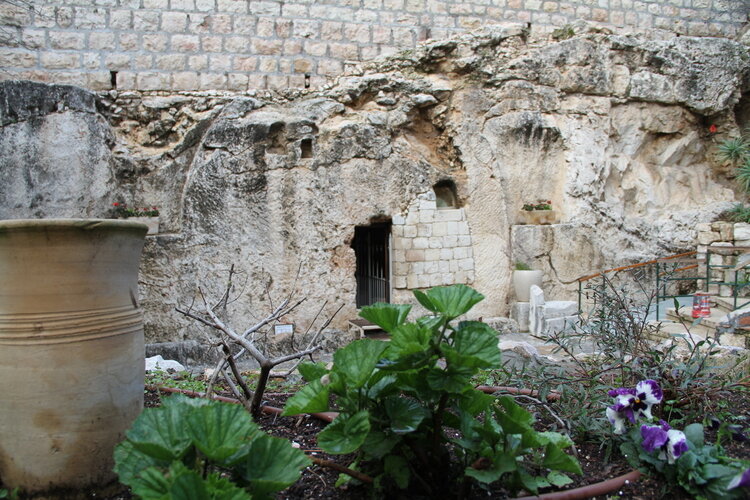Seamless Robes and Grave Clothes
Ken Gibson meditates on the clothes Jesus wore
Reading the Easter story, I’m fascinated by some of the details: carefully noted yet often overlooked when we read too quickly. We're told, in John 19 : 23, that when the soldiers crucified Jesus, they divided His clothes into four shares. That wasn't unusual.
Crucifixion was a gruesome business. One of the soldiers’ rewards was a share in the victim’s possessions. If you read the chapter quickly, you might skip the next sentence but you’d lose a whole depth of meaning. Having divided the clothes into piles, one for each of them, the soldiers were left with Jesus' tunic. The Gospel says, "This garment was seamless, woven in one piece from top to bottom."
Reading this, my mind starts to race. The robe was seamless, "woven in one piece from top to bottom." A description that many might take as a casual comment sparks a list of questions in my mind.
A seamless robe was a precious item. It's no wonder the soldiers gambled for it. So, where did the itinerant Jesus get such a valuable piece of clothing? Perhaps one of the women who followed Him made it. Was it a gesture of thanks for a miracle performed: a child raised from the dead, a husband healed or a marriage restored? Perhaps a gift from the happy couple whose wedding He saved at Cana? We’re not told.
I’m wondering what, ultimately, happened to that robe. Tradition, outside the Bible, has three answers. All three say that the soldier who won it sold it to a traveller. One says it ended up in Trier, Germany. Another places it in Paris, France. The third suggests the country known as Georgia. I like the Georgian option because that tradition says the tunic is still in one piece. But just because I like it doesn’t make it true.
Special Significance
The first century followers were Jews, fully versed in Jewish tradition. When they read or heard John’s Gospel, we can be sure they understood the significance of the seamless robe. They would have known that Leviticus 21 commanded the High Priest to wear a seamless robe. Subtly, but powerfully, the Gospel points out that Jesus wore the uniform of the High Priest: entirely appropriate for the One who was to atone for the sins of the world.
The first century followers were Jews, fully versed in Jewish tradition. When they read or heard John’s Gospel, we can be sure they understood the significance of the seamless robe. They would have known that Leviticus 21 commanded the High Priest to wear a seamless robe. Subtly, but powerfully, the Gospel points out that Jesus wore the uniform of the High Priest: entirely appropriate for the One who was to atone for the sins of the world.
“The Gospel points out that Jesus wore the uniform of the High Priest.”
But there's more! While it was common for people to rip their clothes, the High Priest was forbidden to rip his. If he did, he invalidated, and brought to an end, his ministry as High Priest. Matthew and Mark both tell us that, when Caiaphas, the High Priest, had finished questioning Jesus, he tore his own robe. Did you ever notice that before? The Gospel writers, collectively, tell us that the old High Priest had been made redundant. His role was invalidated and he had been replaced.
It was the High Priest who entered into God’s presence in the Holy of Holies, offering to God for the sins of the people. He was the only one who could mediate between humankind and God. He did this behind a curtain that separated the ordinary Jew from God’s presence. Matthew and Luke tell us that, at the moment Jesus died, the temple curtain was torn in two.
On that first Good Friday, the last barrier between God and man was breached. The message is clear: the High Priest, who had been the only intermediary between God and humankind, has been replaced by Jesus and, through His death and resurrection, we all have access to the presence of God…. There is no barrier!
Prophesy fulfilled!
Back in John 19, the soldiers gambled for Jesus’ robe. “Let’s not tear it,” they said. “Let’s decide by lot who will get it.” John 19 : 24, however, offers an important comment: “This happened that the scripture might be fulfilled that said, ‘they divided my clothes among them and cast lots for my garment.’”
Seeing what happened at the foot of the cross that day, the Gospel writer reflects on Jewish prophecy. Every Jew would have been familiar with the words of Psalm 22, which he quotes. Written centuries earlier, that Psalm offers confirmation that Jesus is the one promised long ago to deliver God’s people from their sin.
Grave clothes
Over in John 20, the writer talks about the grave clothes that Jesus wore. The detail, again, is fascinating. Simon Peter, we’re told, went into the tomb and saw the cloth that had been wrapped around Jesus' head lying there. He also saw the strips of linen that had been wrapped around His body. This is hugely significant. Whatever happened in the tomb that morning, we can be sure that nobody stole the body. Thieving disciples would not have delayed to remove the linen.
The head cloth was still lying in its place separate from the linen. Why would they be separate? Well, wouldn’t it make sense that the head cloth would be removed first so that Jesus could then see to the other cloths?
“Whatever happened in the tomb that morning, we can be sure that nobody stole the body.”
Could it be that an angel came and removed the head cloth for Jesus? If he did, it's likely he folded it where he removed it while Jesus attended, separately, to unwrapping the other bandages. It’s interesting that all three of the other Gospels mention the presence of angels at the tomb.
When Jesus appeared to Mary and the men on the road to Emmaus, nothing in the accounts suggest anything unusual about the way He was dressed. Somehow He was buried in grave clothes but appeared in normal clothes. Have you ever wondered where He might have got those clothes?
I’m speculating again, but wouldn’t it be neat if the angel who removed His head covering also brought Him a change of clothes?



